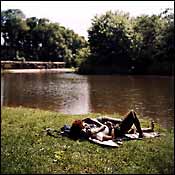
Debating the relative merits of Central Park and Prospect Park is a bit like arguing over whether the Atlantic or the Pacific is the better ocean—which makes it precisely the kind of issue that can elevate the blood pressure of Brooklynites. For residents of the southlands east of the East River, it’s no contest: The diamond-shaped expanse of Prospect Park surpasses the inelegant Manhattanite rectangle on all counts—aesthetic, recreational, and, since we’re talking Brooklyn, spiritual. Flatbushers are apt to assault listeners with the claim that Frederick Law Olmsted, who designed both parks, along with partner Calvert Vaux, considered Prospect Park to be his “masterpiece.” Archivist Jessica Weglein of the Prospect Park Alliance sadly admits that the claim is apocryphal. Brooklyn translation: Olmsted should have said it, would have said it, must have said it.
The two parks are the yin and yang of grassy knolls. Central Park, which this year celebrates the 150th anniversary of the real-estate deal that secured its 843 acres, never lets you forget that you are occupying choice square footage, where but for the grace of God an office tower would rise. The city’s silhouette is the horizon of Central Park’s big sky. Prospect Park, on the other hand, provides a full-blooded nineteenth-century illusion of retreat from the depredations of urbanity. Unlike Central Park, Prospect Park was not designed to accommodate the flow of traffic, and extends in long, unbroken lines, its topography defined by more dips, curves, hollows, and oscillations than a cheerleader from Canarsie. Although at 526 acres it is some 40 percent smaller than its inner-borough rival, Prospect Park is dominated by uninterrupted woodlands, ensuring that it’s a far easier place in which to get lost and enjoy a jolt of primal fairy-tale-child-abandoned-in-the-forest elation. (If you get too turned around, Hansel, you can always follow a trail of discarded condom wrappers back home.)
The centerpiece of Prospect Park—the recently rehabilitated Ravine, built along the terminal moraine of a glacier that retreated 10,000 years ago, cut through by a gorge and featuring three true-to-life burbling waterfalls—is a marvel of manufactured nature: a landscape dense with oaks and cherry trees and sweet gums, whose vista constantly changes depending on where you wander. No buildings or roads are visible; even the barbecuing hordes on the park’s perimeter seem as far away as Nathan’s.
There are no Rollerblading supermodels in Prospect Park, and no dreary horse-and-buggy rides for shopping-bag-toting Nebraskans, and, with 6 million annual visitors—compared with Central Park’s 20 million—there’s a much lower density of human traffic. Prospect Park is by and large a neighborhood park, not a manicured showpiece for tourists.
When summer nights fall, Prospect Park takes on an upstate vibe—low-key and folksy. Neighbors picnic with neighbors. Parents tend to their dozing toddlers. Couples kick off their Birkenstocks and dance at the Bandshell on the grass. It’s not the bucolic ebbing of day Olmsted might have envisioned, but it puts a bit of Brooklyn street life back into the Brooklyn idyll.
See also:
Pound Ridge Reservation, Westchester Park
Central Park